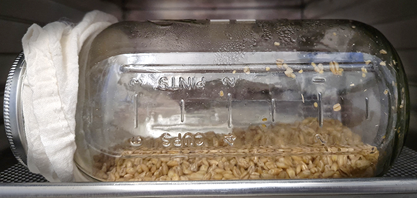Your checkoff dollars at work
Author: Hannah Turner
One reason Craft Beer has gained such popularity is the unique flavors and ingredients adventurous brewers incorporate into their beverages. Ranging from highly traditional to off-the wall, you can find a good spectrum of flavor and styles to suit your taste. An old tradition that is starting to be adopted in a new way by forward thinking American brewers is koji processing, a practice widely found in Asian cultures. Utilized for centuries (originally discovered in Japan’s Muromachi Period of 1136-1573), koji is commonly used to modify grain for use in sake, soy sauce, miso, and shoyu (Japanese soy sauce). The process utilizes fungi (commonly Aspergillus oryzae) to modify grain prior to fermentation and the product is a loosely comparable alternative to traditional Western malt. Koji “malts”, having a lower enzymatic profile, would be used similarly to other adjunct grains in a brewers grist bill. Like malting, koji processing promotes the breakdown of grain structures and development of the enzymes required for starch to sugar breakdown, a key aspect for fermentation. Koji can be applied to many different types of grain and other starch sources, but commonly barley, rice and soybeans are used. Many tend to associate koji with sake, and akin to sake, Koji malts can evoke desirable flavors well outside the realm of malt, such as apple, tropical fruit, and citrus! These flavors come about in part from the fungi’s production of citric, succinic, and kojic acids.
Koji processing starts by washing the grain, then allowing it to soak and pick up moisture. In the case of barley either hull-less or pearled options would be used rather than the hulled malt barley commonly known to brewers. Working without a hull allows the fungi better access to the grains central starch reserve. Post washing the grain is steam cooked, gelatinizing the hydrated starch and achieving sterilization prior to adding the fungi. This ensures only the targeted koji fungus is growing in the coming fermentation step. Next, the grains are sprinkled with koji starter and kept in warm, high humidity conditions for roughly a day, allowing the fungi begin the transformation. During incubation the grains may be agitated to break up the koji a bit. Once completed the grain can be used directly or dried to preserve the final product.
Examples where you might find a brewer has taken advantage of Koji include sour beers, where adding koji to the mash (say for example in a Berliner weisse) will dramatically cut the time needed to properly kettle sour a beer. An inclusion rate of 25% koji can cut down souring time from a weekend long stew to souring within a typical 1 hour mash time. In addition to bespoke flavor, Koji has other potential benefits, for example Kojic acid is noted for its inhibition of oxidation, which might suggest some utility in counteracting astringency that arises from oxidation. Additionally, Koji fermented grains are touted for having health benefits such as digestion aid via improvement of intestinal flora, acting positively for skin condition, and maintaining body immunity. Who could complain about a cold beer that may have some health benefits?!
If you consider yourself a foody or an adventurous beverage seeker you’re probably interested to learn where you might find a Koji beer. As this trend is on the very cutting edge you might be hard pressed, but as more and more interest is popping up you are likely to see options in the near future. Some known opportunities are out of Ronin Fermentation Project based in California, and Matchbook Distilling in New York – both of which are highly worth checking out! If you’re really hoping to learn more about this unique process closer to home in Montana you could also schedule a tour with us in the Barley, Malt & Brewing Quality Lab at MSU Bozeman. We’ll happily dig into the science behind this novel ingredient with you! Through the first half of 2022 we will be hosting visiting PhD candidate Aline Brito, who is investigating several koji strains. Aline is working to develop the ideal processing conditions, assess what impact this has on quality, and brew beers for flavor assessment.

Specifically, the koji work we are doing on campus makes use of Buzz barley, a spring two-row type that was released from the MSU in 2019. Buzz incorporates characteristics which allow it to maintain stable plumps and low protein under dryland growing conditions. These traits particularly shined in last year’s extreme drought conditions, allowing this variety to maintain malting quality while much of the US malt barley crop ended up as feed due to poor conditions. Although Buzz is a traditional hulled type, Brito’s work is making use of grain which was pearled by Montana Milling in Great Falls, removing ~10-15% of the outer grain surface. A.k.a. “dehulling”, this process sands or polishes off the outer seed layers, allowing the koji fungi better access to the inner starchy endosperm of the seed. We are excited to see what comes of koji processing in combination with Buzz as, in blind sensory trials, we have found that brewers tend to prefer Buzz over other varieties! More info can be found on Buzz on our website in our Barley Variety dictionary: www.montana.edu/barleybreeding/learning-center/barley-variety-dictionary/
Brito’s project has two objectives: 1) To evaluate how changes in koji-barley fermentation steeping and fermentation time influence koji metabolites and malt quality, and 2) To determine end quality and sensory profiles of beers brewed with the products of her work. She has now generated koji malts and evaluated them via hot steep sensory (think of this like making koji tea) and analytically. Based on that information we selected products to brew with and beers are currently being evaluating via sensory panels as well as metabolomic analysis to determine how chemical profiles are affected. The chemical profiles will be paired with sensory data to further understand consumer preference.
This project is a fun and exciting way for us to explore the art of developing culinary products for the brewing industry and we are thrilled to learn and collaborate with Brito. We hope to see you out and about this summer and would love to chat more on this project as we intend to man an educational booth at various brew fests around the state – perhaps if you seek us out, we will have some Koji Buzz for you to sample!

